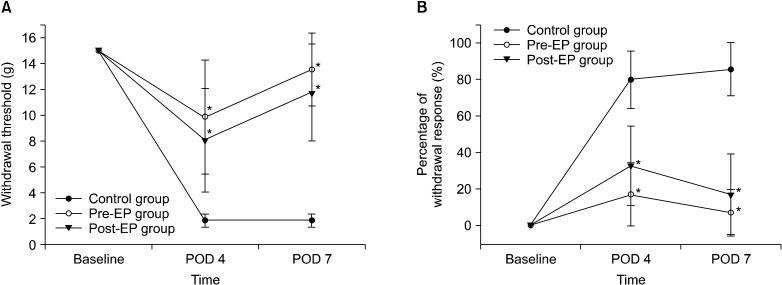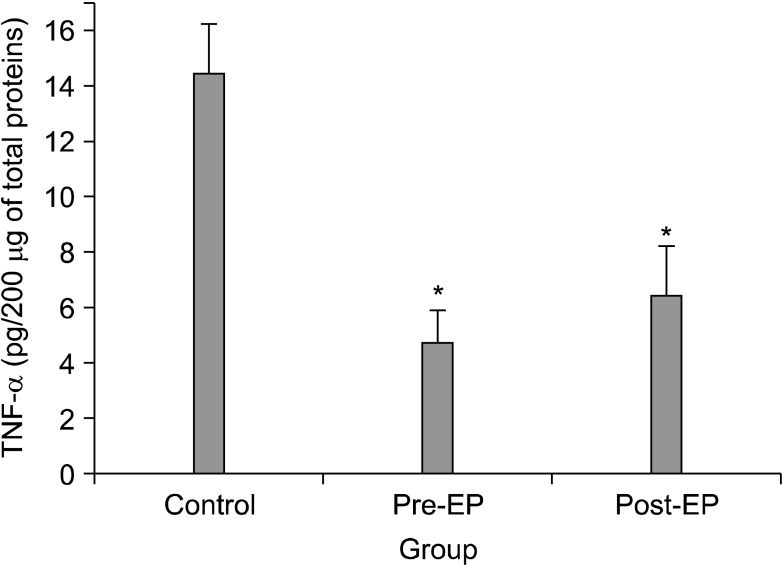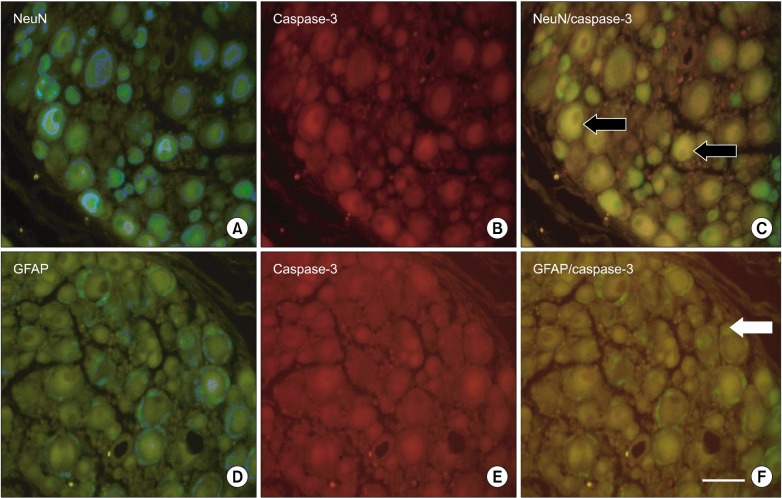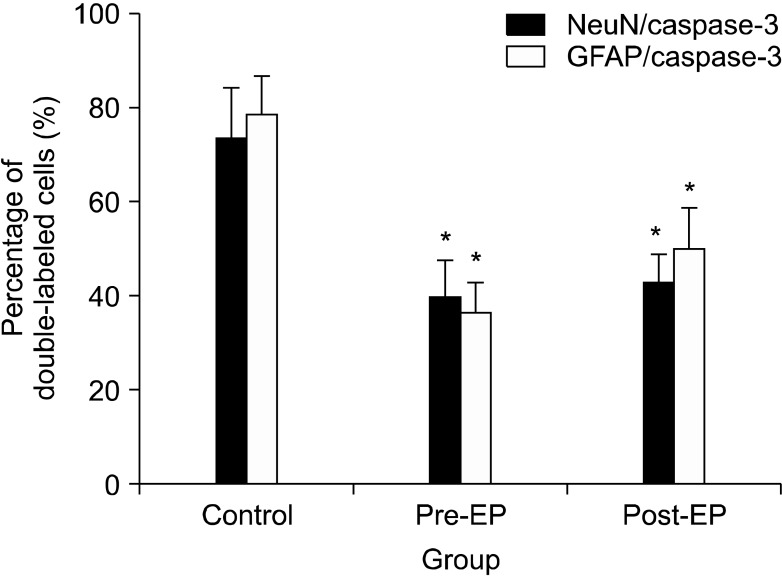Korean J Pain.
2012 Oct;25(4):213-220. 10.3344/kjp.2012.25.4.213.
Effects of Ethyl Pyruvate on Allodynia, TNF-alpha Expression, and Apoptosis in the Dorsal Root Ganglion after Spinal Nerve Ligation Injury
- Affiliations
-
- 1Department of Anesthesiology and Pain Medicine, Asan Medical Center, University of Ulsan College of Medicine, Seoul, Korea. jgleem@amc.seoul.kr
- KMID: 2278161
- DOI: http://doi.org/10.3344/kjp.2012.25.4.213
Abstract
- BACKGROUND
It has been demonstrated that the expression of tumor necrosis factor-alpha (TNF-alpha) and apoptotic cell death in the dorsal root ganglion (DRG) following spinal nerve constriction injury play a role in the initiation and continuation of hyperalgesia and allodynia. The present study was designed to investigate the effects of ethyl pyruvate (EP) on mechanical and cold allodynia, TNF-alpha expression, and apoptosis in DRG after spinal nerve ligation injury.
METHODS
Rats were divided into 3 groups: control, pre-EP, and post-EP. EP (50 mg/kg) was intraperitoneally injected 30 minutes before (pre-EP) or after (post-EP) surgery. Behavioral tests to determine mechanical and cold allodynia were conducted before surgery and 4 and 7 days after surgery. Seven days after surgery, TNF-alpha protein levels in DRG were evaluated by enzyme-linked immunosorbent assay, and DRG apoptosis was determined by immunohistochemical detection of activated caspase-3.
RESULTS
Treatment with EP significantly reduced mechanical and cold allodynia following spinal nerve ligation injury. TNF-alpha protein levels in the pre-EP (4.7 +/- 1.2 pg/200 microg; P < 0.001) and post-EP (6.4 +/- 1.8 pg/200 microg; P < 0.001) groups were 2-3 times lower than the control group (14.4 +/- 1.2 pg/200 microg). The percentages of neurons and satellite cells that co-localized with caspase-3 were also significantly lower in the pre-EP and post-EP groups than the control group.
CONCLUSIONS
These results demonstrate that EP has a strong anti-allodynic effect that acts through the inhibition of TNF-alpha expression and apoptosis in DRG after spinal nerve ligation injury.
MeSH Terms
-
Animals
Apoptosis
Caspase 3
Cell Death
Cold Temperature
Constriction
Diagnosis-Related Groups
Enzyme-Linked Immunosorbent Assay
Ganglia, Spinal
Hyperalgesia
Ligation
Neurons
Pyruvates
Pyruvic Acid
Rats
Spinal Nerve Roots
Spinal Nerves
Tumor Necrosis Factor-alpha
Caspase 3
Pyruvates
Pyruvic Acid
Tumor Necrosis Factor-alpha
Figure
Cited by 1 articles
-
Effect of Ethyl Pyruvate on Paclitaxel-Induced Neuropathic Pain in Rats
Seong Soo Choi, Won Uk Koh, Jae Sik Nam, Jin Woo Shin, Jeong Gill Leem, Jeong Hun Suh
Korean J Pain. 2013;26(2):135-141. doi: 10.3344/kjp.2013.26.2.135.
Reference
-
1. Kim SH, Chung JM. An experimental model for peripheral neuropathy produced by segmental spinal nerve ligation in the rat. Pain. 1992; 50:355–363. PMID: 1333581.
Article2. Schäfers M, Geis C, Brors D, Yaksh TL, Sommer C. Anterograde transport of tumor necrosis factor-alpha in the intact and injured rat sciatic nerve. J Neurosci. 2002; 22:536–545. PMID: 11784800.
Article3. Kim SH, Nam JS, Choi DK, Koh WW, Suh JH, Song JG, et al. Tumor necrosis factor-alpha and apoptosis following spinal nerve ligation injury in rats. Korean J Pain. 2011; 24:185–190. PMID: 22220239.
Article4. Ohtori S, Takahashi K, Moriya H, Myers RR. TNF-alpha and TNF-alpha receptor type 1 upregulation in glia and neurons after peripheral nerve injury: studies in murine DRG and spinal cord. Spine (Phila Pa 1976). 2004; 29:1082–1088. PMID: 15131433.
Article5. Dubový P, Jancálek R, Klusáková I, Svízenská I, Pejchalová K. Intra- and extraneuronal changes of immunofluorescence staining for TNF-alpha and TNFR1 in the dorsal root ganglia of rat peripheral neuropathic pain models. Cell Mol Neurobiol. 2006; 26:1205–1217. PMID: 16705482.6. Miao P, Madec K, Gong Y, Shen H, Eisenstat D, Melanson M, et al. Axotomy-induced up-regulation of tumor necrosis factor-alpha in the dorsal root ganglia. Neurol Res. 2008; 30:623–631. PMID: 18489817.
Article7. Homma Y, Brull SJ, Zhang JM. A comparison of chronic pain behavior following local application of tumor necrosis factor alpha to the normal and mechanically compressed lumbar ganglia in the rat. Pain. 2002; 95:239–246. PMID: 11839423.
Article8. Wagner R, Myers RR. Endoneurial injection of TNF-alpha produces neuropathic pain behaviors. Neuroreport. 1996; 7:2897–2901. PMID: 9116205.
Article9. Wei XH, Zang Y, Wu CY, Xu JT, Xin WJ, Liu XG. Peri-sciatic administration of recombinant rat TNF-alpha induces mechanical allodynia via upregulation of TNF-alpha in dorsal root ganglia and in spinal dorsal horn: the role of NF-kappa B pathway. Exp Neurol. 2007; 205:471–484. PMID: 17459378.
Article10. Sweitzer S, Martin D, DeLeo JA. Intrathecal interleukin-1 receptor antagonist in combination with soluble tumor necrosis factor receptor exhibits an anti-allodynic action in a rat model of neuropathic pain. Neuroscience. 2001; 103:529–539. PMID: 11246166.
Article11. Schäfers M, Lee DH, Brors D, Yaksh TL, Sorkin LS. Increased sensitivity of injured and adjacent uninjured rat primary sensory neurons to exogenous tumor necrosis factor-alpha after spinal nerve ligation. J Neurosci. 2003; 23:3028–3038. PMID: 12684490.
Article12. Shubayev VI, Myers RR. Axonal transport of TNF-alpha in painful neuropathy: distribution of ligand tracer and TNF receptors. J Neuroimmunol. 2001; 114:48–56. PMID: 11240015.
Article13. Chen M, Wang J. Initiator caspases in apoptosis signaling pathways. Apoptosis. 2002; 7:313–319. PMID: 12101390.14. Joseph EK, Levine JD. Caspase signalling in neuropathic and inflammatory pain in the rat. Eur J Neurosci. 2004; 20:2896–2902. PMID: 15579143.
Article15. Scholz J, Broom DC, Youn DH, Mills CD, Kohno T, Suter MR, et al. Blocking caspase activity prevents transsynaptic neuronal apoptosis and the loss of inhibition in lamina II of the dorsal horn after peripheral nerve injury. J Neurosci. 2005; 25:7317–7323. PMID: 16093381.
Article16. Yu YM, Kim JB, Lee KW, Kim SY, Han PL, Lee JK. Inhibition of the cerebral ischemic injury by ethyl pyruvate with a wide therapeutic window. Stroke. 2005; 36:2238–2243. PMID: 16141417.
Article17. Wang Q, Ding Q, Zhou Y, Gou X, Hou L, Chen S, et al. Ethyl pyruvate attenuates spinal cord ischemic injury with a wide therapeutic window through inhibiting high-mobility group box 1 release in rabbits. Anesthesiology. 2009; 110:1279–1286. PMID: 19417608.
Article18. Genovese T, Esposito E, Mazzon E, Di Paola R, Meli R, Caminiti R, et al. Beneficial effects of ethyl pyruvate in a mouse model of spinal cord injury. Shock. 2009; 32:217–227. PMID: 18948848.
Article19. Cho IH, Kim SW, Kim JB, Kim TK, Lee KW, Han PL, et al. Ethyl pyruvate attenuates kainic acid-induced neuronal cell death in the mouse hippocampus. J Neurosci Res. 2006; 84:1505–1511. PMID: 16958132.
Article20. Shang GH, Lin DJ, Xiao W, Jia CQ, Li Y, Wang AH, et al. Ethyl pyruvate reduces mortality in an endotoxin-induced severe acute lung injury mouse model. Respir Res. 2009; 10:91. PMID: 19799777.
Article21. Guo J, Zhang K, Ji Y, Jiang X, Zuo S. Effects of ethyl pyruvate on myocardial apoptosis and expression of Bcl-2 and Bax proteins after ischemia-reperfusion in rats. J Huazhong Univ Sci Technolog Med Sci. 2008; 28:281–283. PMID: 18563323.
Article22. Tsung A, Kaizu T, Nakao A, Shao L, Bucher B, Fink MP, et al. Ethyl pyruvate ameliorates liver ischemia-reperfusion injury by decreasing hepatic necrosis and apoptosis. Transplantation. 2005; 79:196–204. PMID: 15665768.
Article23. Li Y, Dorsi MJ, Meyer RA, Belzberg AJ. Mechanical hyperalgesia after an L5 spinal nerve lesion in the rat is not dependent on input from injured nerve fibers. Pain. 2000; 85:493–502. PMID: 10781924.
Article24. Suzuki R, Dickenson AH. Neuropathic pain: nerves bursting with excitement. Neuroreport. 2000; 11:R17–R21. PMID: 10976929.25. Woolf CJ, Salter MW. Neuronal plasticity: increasing the gain in pain. Science. 2000; 288:1765–1769. PMID: 10846153.
Article26. Sekiguchi M, Sekiguchi Y, Konno S, Kobayashi H, Homma Y, Kikuchi S. Comparison of neuropathic pain and neuronal apoptosis following nerve root or spinal nerve compression. Eur Spine J. 2009; 18:1978–1985. PMID: 19543754.
Article27. Schaeffer V, Meyer L, Patte-Mensah C, Eckert A, Mensah-Nyagan AG. Sciatic nerve injury induces apoptosis of dorsal root ganglion satellite glial cells and selectively modifies neurosteroidogenesis in sensory neurons. Glia. 2010; 58:169–180. PMID: 19565659.
Article28. Empl M, Renaud S, Erne B, Fuhr P, Straube A, Schaeren-Wiemers N, et al. TNF-alpha expression in painful and nonpainful neuropathies. Neurology. 2001; 56:1371–1377. PMID: 11376190.
Article29. Kao KK, Fink MP. The biochemical basis for the anti-inflammatory and cytoprotective actions of ethyl pyruvate and related compounds. Biochem Pharmacol. 2010; 80:151–159. PMID: 20230800.
Article30. Ulloa L, Ochani M, Yang H, Tanovic M, Halperin D, Yang R, et al. Ethyl pyruvate prevents lethality in mice with established lethal sepsis and systemic inflammation. Proc Natl Acad Sci U S A. 2002; 99:12351–12356. PMID: 12209006.
Article31. Campana WM, Myers RR. Exogenous erythropoietin protects against dorsal root ganglion apoptosis and pain following peripheral nerve injury. Eur J Neurosci. 2003; 18:1497–1506. PMID: 14511329.
Article32. Sekiguchi M, Kobayashi H, Sekiguchi Y, Konno S, Kikuchi S. Sympathectomy reduces mechanical allodynia, tumor necrosis factor-alpha expression, and dorsal root ganglion apoptosis following nerve root crush injury. Spine (Phila Pa 1976). 2008; 33:1163–1169. PMID: 18469688.
Article33. Jancálek R, Dubový P, Svízenská I, Klusáková I. Bilateral changes of TNF-alpha and IL-10 protein in the lumbar and cervical dorsal root ganglia following a unilateral chronic constriction injury of the sciatic nerve. J Neuroinflammation. 2010; 7:11. PMID: 20146792.
- Full Text Links
- Actions
-
Cited
- CITED
-
- Close
- Share
- Similar articles
-
- Tumor Necrosis Factor-alpha and Apoptosis Following Spinal Nerve Ligation Injury in Rats
- Effect of Ethyl Pyruvate on Paclitaxel-Induced Neuropathic Pain in Rats
- Role of Nitric Oxide in a Spinal Ligation Model of Neuropathic Pain
- The Expression of the Ca++ Channel alpha2delta Subunit and TRPM8 in the Dorsal Root Ganglion of Sympathetically Maintained Pain and Sympathetic Independent Pain Rat Models
- Tramadol, Alpha-2 Adrenalin Receptor Subtype and Neuropathic Rat Model





